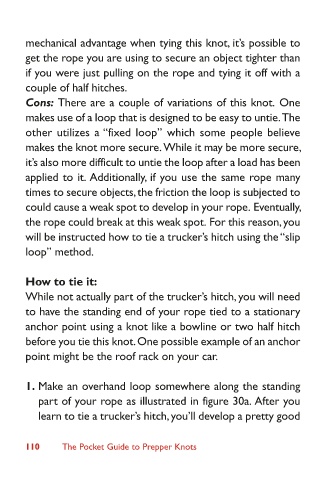Page 116 - Patty Hahne "The Pocket Guide to Prepper Knots"
P. 116
mechanical advantage when tying this knot, it’s possible to
get the rope you are using to secure an object tighter than
if you were just pulling on the rope and tying it off with a
couple of half hitches.
Cons: There are a couple of variations of this knot. One
makes use of a loop that is designed to be easy to untie. The
other utilizes a “fixed loop” which some people believe
makes the knot more secure. While it may be more secure,
it’s also more difficult to untie the loop after a load has been
applied to it. Additionally, if you use the same rope many
times to secure objects, the friction the loop is subjected to
could cause a weak spot to develop in your rope. Eventually,
the rope could break at this weak spot. For this reason, you
will be instructed how to tie a trucker’s hitch using the “slip
loop” method.
How to tie it:
While not actually part of the trucker’s hitch, you will need
to have the standing end of your rope tied to a stationary
anchor point using a knot like a bowline or two half hitch
before you tie this knot. One possible example of an anchor
point might be the roof rack on your car.
1. Make an overhand loop somewhere along the standing
part of your rope as illustrated in figure 30a. After you
learn to tie a trucker’s hitch, you’ll develop a pretty good
110 The Pocket Guide to Prepper Knots

